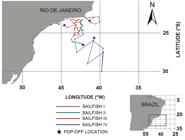Pop-up satellite archival tags (PSATs) were deployed on four sailfish, Istiophorus platypterus, in the coastal waters of Rio de Janeiro State in southeast Brazil during January and February of 2009 (sailfish I and II) and between November 2010 and January 2011 (sailfish III and IV). The total number of days monitored (i.e., time that the tags remained attached) were 12 (sailfish I), 51 (sailfish II), 16 (sailfish III) and 43 days (sailfish IV). The results indicate a clear pattern of vertical habitat utilization with the majority of the time spent concentrated near the uniform sea surface layer occupying a relatively narrow temperature range. Despite the clear preference for epipelagic surface waters, sailfish regularly undertook vertical excursions into deeper waters (>50 m) within three to six hour intervals. "Most Probable Tracks" (estimated from raw geolocations using the state-space Kalman filter model) and linear displacements suggested that tagged sailfish did not move significant distances from the tagging site. In brief, our report provides information regarding the biology of sailfish in the southwestern Atlantic and how vertical distributions during the day and night are influenced by water temperature and how this information can improve sailfish stock assessments in southwestern Atlantic Ocean.
Delta SST; Horizontal movements; Pop-up satellite archival tags (PSATs); Sailfish; Southwest Atlantic; Vertical habitat

 Thumbnail
Thumbnail
 Thumbnail
Thumbnail
 Thumbnail
Thumbnail
 Thumbnail
Thumbnail



